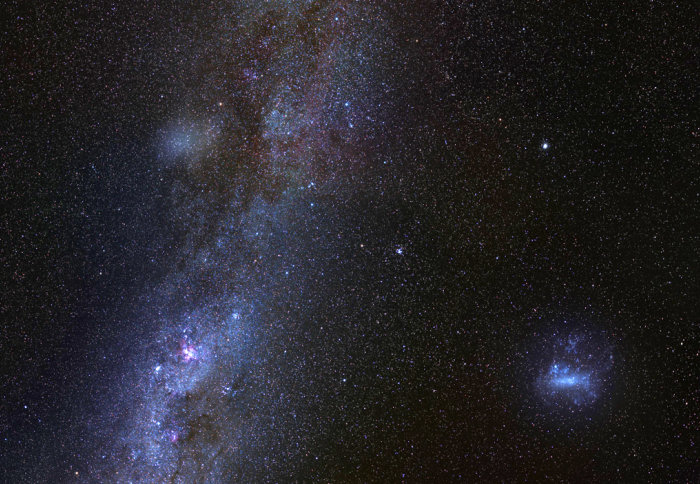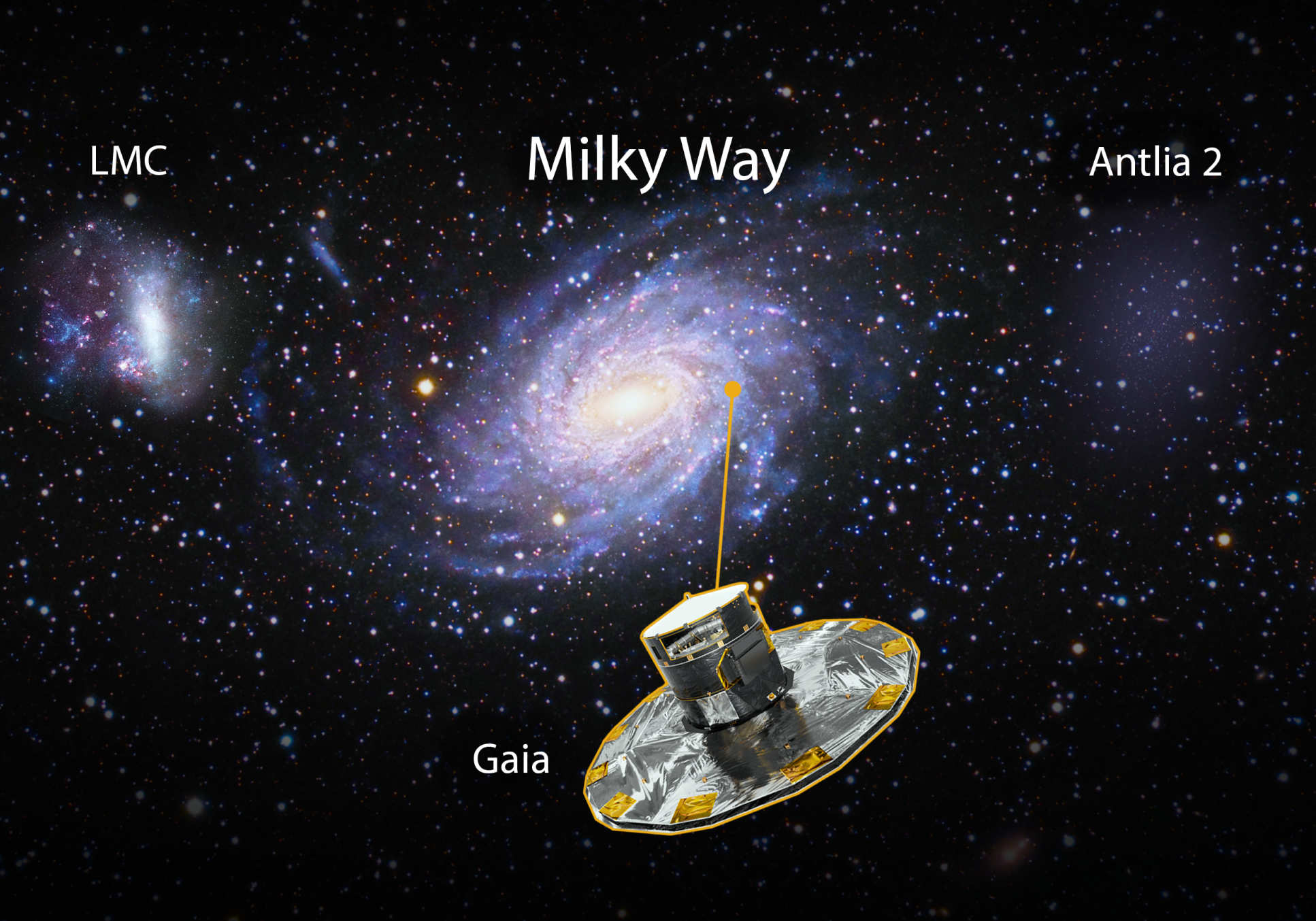
The Milky Way with the Large Magellanic Cloud (bottom-right) and Antila 2 (top-left)

A galaxy a third the size of our own, but extremely faint, has been observed orbiting around the Milky Way.
An international team, including an astronomer from Imperial College London, discovered the massive galaxy when trawling through data from the European Space Agency’s Gaia satellite. Despite its size, the galaxy has very few stars, challenging conventional theories of galaxy formation.
Antlia 2 might be hinting towards some new fundamental forces at work. Dr Alex Geringer-Sameth
The galaxy, named Antlia 2 (or Ant 2), has avoided detection until now thanks to its extremely low density as well as a perfectly chosen hiding place, behind the Milky Way’s bright central disc.
Ant 2 is known as a dwarf galaxy. As structures emerged in the early Universe, dwarfs were the first galaxies to form, and so most of their stars are now old, relatively low in terms of their mass, and poor in metals.
However, compared to the other known dwarf galaxies orbiting the Milky Way, Ant 2 is immense. It is as big as the Large Magellanic Cloud (LMC), a bright satellite galaxy that is a third the size of the Milky Way itself.
New fundamental forces at work?
Ant 2 is also unusual because of how little light it gives out: compared to the LMC, Ant 2 is 10,000 times fainter, meaning that it has about one 10,000th the number of stars.
Current theories of galaxy formation cannot fully explain how a galaxy so large has so few stars. Previous research has suggested that some dwarfs could be inflated by vigorous star formation, causing the galaxy to ‘puff up’, but the new research shows that this process would have to be remarkably efficient to explain Ant 2.
Alternatively, the properties of the elusive ‘dark matter’, thought to keep galaxies together, might need to be re-thought. The currently favoured theory predicts that dark matter packs tightly in the centres of galaxies, but a dark matter particle which is less keen to cluster may be required.
Co-author Dr Alex Geringer-Sameth, from the Department of Physics at Imperial, said: “Antlia 2 might be hinting towards some new fundamental forces at work — in particular that dark matter might not behave as simply as has been assumed in the standard model of cosmology.”
Enough data to spot a ghost
The researchers behind the current study – from Taiwan, the UK, the US, Australia and Germany – searched the new Gaia data looking for Milky Way satellites by using RR Lyrae stars. These stars are old and metal-poor, typical of those found in dwarf galaxies.

The ESA’s Gaia mission has produced the richest star catalogue to date, including high-precision measurements of nearly 1.7 billion stars and revealing previously unseen details of our home galaxy. Earlier this year, Gaia’s second data release made new details of stars in the Milky Way available to scientists worldwide.
Lead author Gabriel Torrealba, from the Institute of Astronomy and Astrophysics at Academia Sinica in Taipei, Taiwan, said: “This is a ghost of a galaxy. Objects as diffuse as Ant 2 have simply not been seen before. Our discovery was only possible thanks to the quality of the Gaia data.”
The tip of the galactic iceberg
The team were able to confirm that the ghostly object they spotted was real by checking with colleagues at the Anglo-Australian Telescope (AAT) in Australia, which showed that all the stars were moving together. The researchers were also able to estimate the galaxy’s mass, which was much lower than expected for an object of its size.
Dr Geringer-Sameth said: “Antlia 2 certainly gives a reason for optimism. One of the many great things about Gaia is that it surveys the entire sky. I love the idea that the next discovery may already be waiting in the public archive of Gaia data. We just have to learn how to spot it.”
Co-author Dr Matthew Walker, from Carnegie Mellon University, added: “We are wondering whether this galaxy is just the tip of an iceberg, and the Milky Way is surrounded by a large population of nearly invisible dwarfs similar to this one.”
-
‘The hidden giant: discovery of an enormous Galactic dwarf satellite in Gaia DR2’ by G. Torrealba, V. Belokurov, S. E. Koposov, T. S. Li, M. G. Walker, J. L. Sanders, A. Geringer-Sameth, D. B. Zucker, K. Kuehn, N. W. Evans2 and W. Dehnen.
Image credits
Top image: G. Torrealba (Academia Sinica, Taiwan), V. Belokurov (Cambridge, UK and CCA, New York, US) based on the image by ESO/S. Brunier
Middle image: V. Belokurov and A. Smith (Cambridge, UK and CCA, New York, US) based on the images by Marcus and Gail Davies and Robert Gendler
-
Based on a press release by the University of Cambridge.
Article text (excluding photos or graphics) © Imperial College London.
Photos and graphics subject to third party copyright used with permission or © Imperial College London.
Reporter
Hayley Dunning
Communications Division

Contact details
Tel: +44 (0)20 7594 2412
Email: h.dunning@imperial.ac.uk
Show all stories by this author
Leave a comment
Your comment may be published, displaying your name as you provide it, unless you request otherwise. Your contact details will never be published.




Comments
Comments are loading...